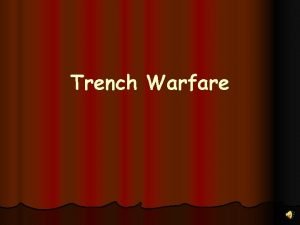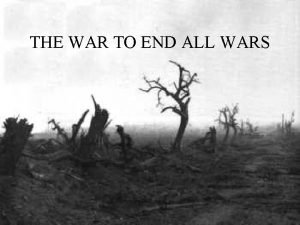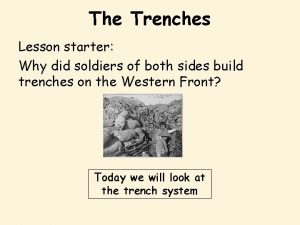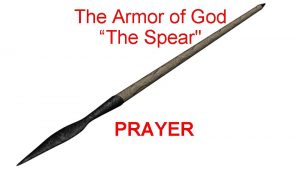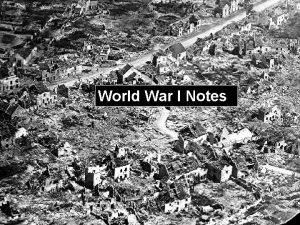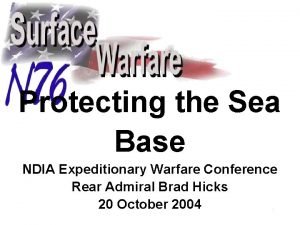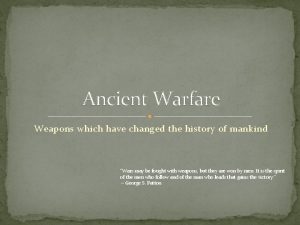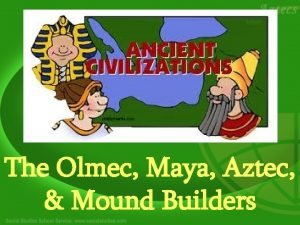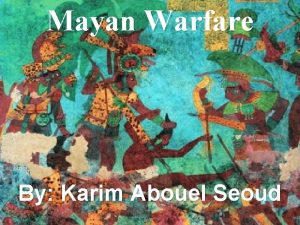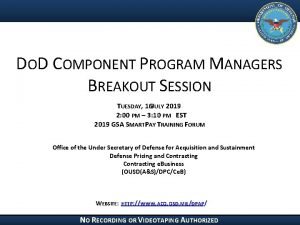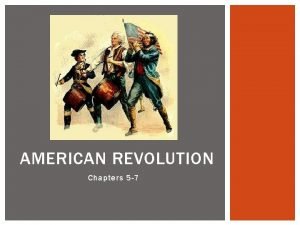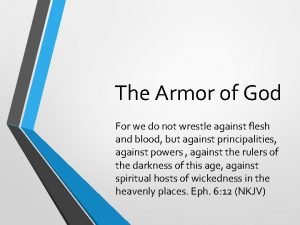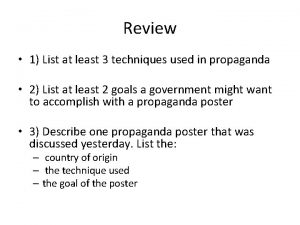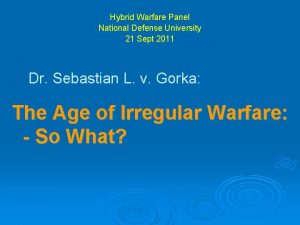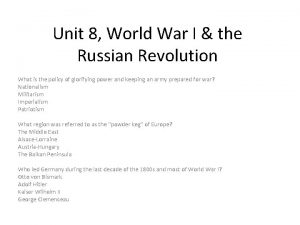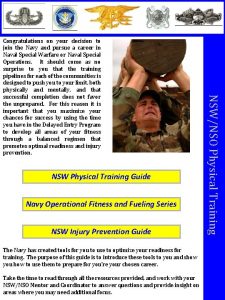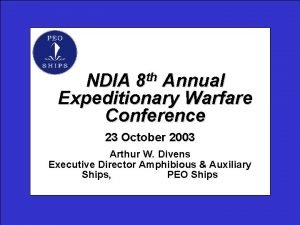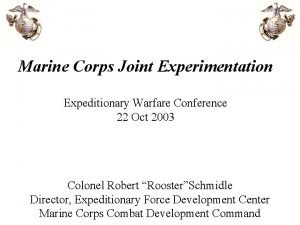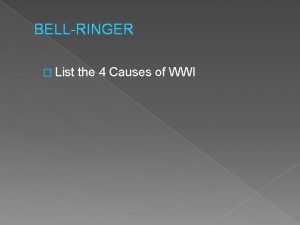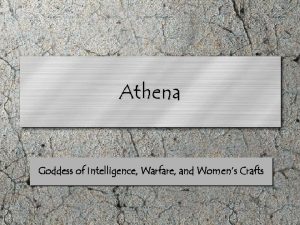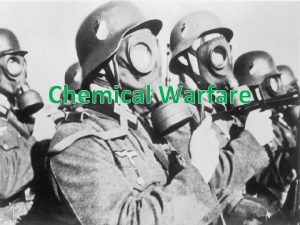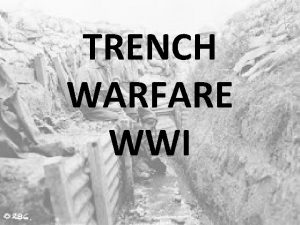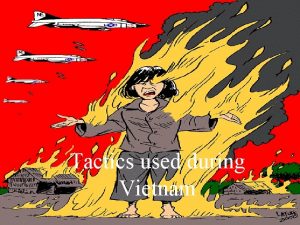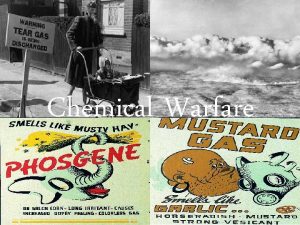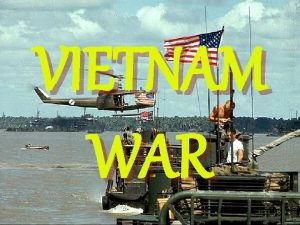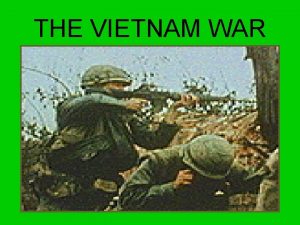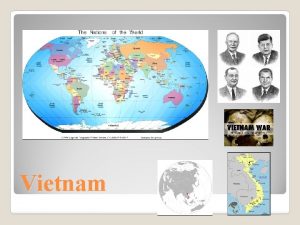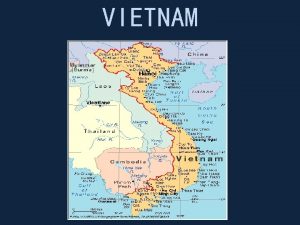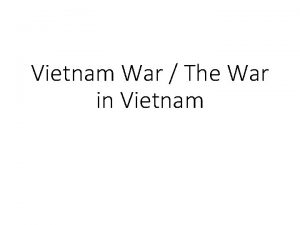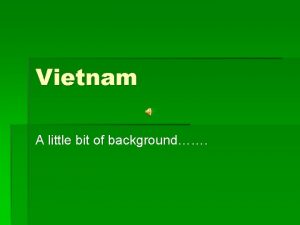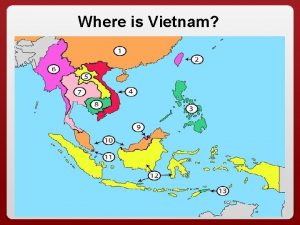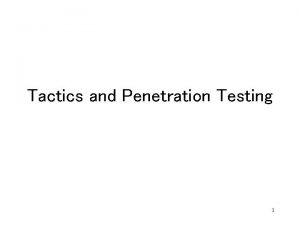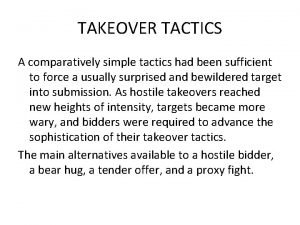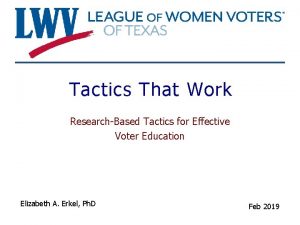Types of Warfare Vietnam The Americans tactics u












































- Slides: 44

Types of Warfare Vietnam

The Americans' tactics u They fought a hi-tech war, using B 52 bombers, artillery, helicopters, napalm and defoliants such as Agent Orange. This killed many innocent civilians, and failed to stop the Vietcong guerrillas. u They forced the peasants to leave Vietcong-controlled areas and made them live in defended strategic hamlets in loyal areas. This created immense opposition, and allowed Vietcong infiltrators into loyal areas.



Types of Warfare - US u Land mine - a victim-triggered explosive device which is intended to damage its target via blast and/or fragments. u Saturation bombing - Saturation bombing, or carpet bombing refers to an extensive and systematic bombing intended to devastate a large target. u Fragmentation bombs – bomb that explodes and sends small metal shards moving at super- to hypersonic speeds outward from it u Agent Orange – Poisonous gas sprayed all of Vietnam that destroyed forests, jungles, and people u Napalm - a thickening/gelling agent generally mixed with gasoline or a similar fuel for use in military operations.




American Tactics cont’d American troops were sent on patrols, then supported by air and artillery when attacked. u This demoralised the soldiers, who realized they were being used just as bait. u Search and destroy patrols went out looking for "Charlie", as they called the Vietcong. But the patrols were very visible, and easy to ambush. u This led to atrocities such as "zippo raids" to burn villages, and the unprovoked massacre of peaceful villagers at My Lai in 1968. u

“Charlie” The name “Charlie " came from the military alphabet abbreviation for the first letters of Viet Cong. u So, these forces were referred to as VC or using the military call signs for the letters, Victor Charlie, shortened to simply 'Charlie'. u Now the north Vietnamese had an army that were referred to as North Vietnamese Regulars. They were 'Victor Romeo‘. u Eventually all Vietnamese that the US soldiers were fighting against became known as Charlie. u

In 1965, General William Westmoreland developed the aggressive strategy of 'search and destroy'. The objective was to find and then kill members of the Vietcong u The US soldiers found this difficult. As one marine captain explained: "You never knew who was the enemy and who was the friend. They all looked alike. They all dressed alike. " Innocent civilians were often killed by mistake. As one Marine officer admitted they "were usually counted as enemy dead, under the unwritten rule 'If he's dead and Vietnamese, he's VC'. " u

Vietcong tactics u They fought a guerrilla war, which is a type of warfare that uses unusual tactics, and in-depth knowledge of local surroundings, to defeat opponents both physically and psychologically. u Examples are: ambushing US patrols, setting booby traps and landmines, and planting bombs in towns. u They mingled in with the peasants, wearing ordinary clothes. The Americans couldn't identify who the enemy was.


Other Vietcong tactics They were supplied with rockets and weapons by China and Russia. u They used the Ho Chi Minh Trail - a jungle route through Laos and Cambodia - to supply their armies. u The Americans couldn't attack their supply routes without escalating the war and attacking these other countries. u Their tactic was "hanging onto the belts" of the Americans - staying so close to the Americans so they could not use air or artillery backup without killing their own men. u

Vietcong tactics cont’d u For destroying armored vehicles or bunkers, the Vietcong had highly effective rocket propelled grenades and rifles. u Many weapons, including booby traps and mines, were homemade in villages. The materials ranged from scavenged tin can to discarded wire, but the most important ingredients were provided by the enemy. u In a year, dud American bombs could leave more than 20, 000 tons of explosives scattered around the Vietnamese countryside. After air-raids, volunteers retrieved the duds and the dangerous business of creating new weapons began.

The Vietcong was told not to go into combat unless it outnumbered the enemy and was certain of winning. It therefore concentrated on attacking small patrols or poorly guarded government positions. To increase its advantage, the Vietcong relied heavily on night attacks. u At first the Vietcong used hand-made weapons such as spears, daggers and swords. However, over a period of time, it built up a large supply of captured weapons. u A US army survey of weapons in 1964 discovered that 90% of weapons taken from the Vietcong had previously belonged to the US army. u

Punji Traps u Local forces also designed primitive weapons, some designed to frighten intruders, but others were extremely dangerous. "Punji traps" -- sharp spikes hidden in pits -- could easily disable an enemy soldier. Punjis were often deliberately contaminated to increase the risk of infection.


Tunnels u Hiding the base areas had always been a high priority for the Vietcong. Now, with American spotter planes everywhere, it was more vital than ever to protect them. u In remote swamps or forests, there were few problems, but nearer the capital, it was much more difficult. The answer was to build enormous systems of underground tunnels.

Tunnels Cont’d The orders coming from NLF headquarters were absolutely clear. Tunnels were not to be treated as mere shelters. They were fighting bases capable of providing continuous support for troops. Even if a village was in enemy hands, the Vietcong beneath were still able to conduct offensive operations. u There were complexes big and small scattered across the country. Each villager in a Vietcong area had to dig three feet of tunnel a day. There was even a standard handbook specifying how tunnels were to be built. The biggest tunnel systems were in the Iron Triangle and the Cu Chi District, only 20 miles from Saigon. u





Booby Trap Markers: Types of markers indicating the location of a booby trap. Often used as pointers by the VC, indicating direction and distance to booby trap.

Grenade Trap: Two cans are tied to trees either side of the track with the delay train and safety pins removed and slide into the cans holding the striker levers in position. A trip wire is tied to both grenades. when the victim's foot pulls the trip wire the grenades are pulled from the cans causing instant detonation.


Door Trap: Two lengths of bamboo with the cross section heavily spiked and is suspended above the door or opening via a trip wire. When the wire is tripped the trap swings down impaling the victim.


The overall strategy of guerrilla warfare is to involve the enemy in a long-drawn out war. The aim is to wear down gradually the much larger and stronger enemy. u It is only when all the rural areas are under their control and they are convinced that they outnumber the opposition, that the guerrillas come out into the open and take part in conventional warfare. u Thus the Vietcong, who were based in the thick forests of South Vietnam, began by taking control of the villages in the rural areas. As their strength grew and the enemy retreated, they began to take the smaller towns. u

Difference in tactics It was Vietminh military leader No Nguyen Giap that masterminded the Vietminh/Vietcong war strategy. u He summed up the different between the Vietcong’s war strategy and the US’s war strategy by claiming it was the “War between the tiger and the elephant. ” u He said: “It is the fight between tiger and elephant. If the tiger stands his ground, the elephant will crush him with its mass. But, if he conserves his mobility, he will finally vanquish the elephant, who bleeds from a multitude of cuts. ” u

A Vietnam Veteran's Story u “We moved out cautiously through thick overhanging vines and heavy underbrush. We were patrolling in Dodge City, on a search and destroy mission. The area was known for its many booby-traps, ambushes, heavy enemy engagements and fierce fire fights. As we moved out I was looking for trip wires hooked to booby traps and smelling the air for the odor of the enemy. In the thick underbrush I knew we would smell them before we could see them.

u “What's that? Screaming. A man is yelling something. My God, he's screaming for his mother! Who is it? Where is he? He's screaming in English, so he must be one of us! Which one? Damn it, why is no one shooting? Can't anyone see the VC. ? No gunfire. This can mean only one thing. Lou, the man to my rear, has moved up next to me. We exchange a look that tells both of us that we have reached the same conclusion. We were now facing that which GIs feared most of all in Vietnam. More than the North Vietnamese Army, more than the Vietcong, more than anything, we feared--the booby trap.

u Lou crawls ahead. He motions for me to follow. I can't. I'm frozen in place. All I can think of is the hidden mechanical deathtraps around me which I could set off with the slightest movement. Time to pull myself together. The screams are getting louder. How much time has passed? An eternity? Lou signals me again. This time I move. Together we cross the distance between us and the source of the screams. It is the longest distance I have ever traveled in my life. With every movement Lou and I expect one of us to set off another mine. There is the strong taste of metal in the back of my throat.

u So strange. No more explosions. No gunfire. Did they only set one trap? Very unusual, and lucky. We made it! However, our elation at having gone the distance without getting killed is dampened immediately by the strange sight of Dave lying there on the ground. Joe is kneeling next to him, staring at him, in shock. Dave is more than a mess. It appears to have been from a landmine. Both his knees are bent 90 degrees in the wrong directions and his fatigues appear to have hundreds of holes in them. Through the holes, blood is spurting everywhere. He must have severed arteries, because the blood acts like it's being pumped. I had no idea people could bleed like that. His screams have turned to moans, and I feel like I'm going to pass out as the others gather around us.

u What's that? There is something not quite right about those trees. Is there someone there? Again, time is distorted. I'm going to die. No, it can't be! I aim at the shadows--my thoughts are interrupted by a small shirtless man jumping out of the brush with arms raised, yelling, "Don't shoot! US Army!”

Question u What is this veteran saying about the type of warfare and how does he react to this situation?

Vietnam Facts u 9, 087, 000 military personnel served on active duty during the official Vietnam era from August 5, 1964 to May 7, 1975. u 2, 709, 918 Americans served in uniform in Vietnam. u Vietnam Veterans represented 9. 7% of their generation. u 240 men were awarded the Medal of Honor during the Vietnam War.

Vietnam Casualties u 58, 148 were killed in Vietnam. u 75, 000 were severely disabled. u 23, 214 were 100% disabled. u 5, 283 lost limbs. u 1, 081 sustained multiple amputations.

Age Range Of those killed, 61% were younger than 21. u 11, 465 of those killed were younger than 20 years old. u Of those killed, 17, 539 were married. u Average of men killed: 23. 1 years. u Five men killed in Vietnam were only 16 years old. u The oldest man killed was 62 years old. u As of January 15, 2004, there are 1, 875 Americans still unaccounted for from the Vietnam War. u

Missing In Action u Missing in Action: 2, 338 u Prisoners of War: 766 (114 died in captivity) u Breakdown by service of those who were returned: Army 121 ( 15 escaped) Air Force 332 ( 1 escaped) Marines 29 ( 10 escaped) Navy 150 ( 2 escaped) Civilian 59 ( 6 escaped) Foreign Nationals 74 ( 2 escaped)


With the addition of one name added in 2009 the total is now 58, 261 names listed on the Memorial. Approximately 1200 of these are listed as MIA's & POW's

 Trench warfare propaganda
Trench warfare propaganda Joint warfare analysis center
Joint warfare analysis center Jewosu
Jewosu Ptsd spiritual warfare
Ptsd spiritual warfare Pros and cons of biological warfare
Pros and cons of biological warfare Unrestricted submarine warfare
Unrestricted submarine warfare Ephesians weapons of warfare
Ephesians weapons of warfare The war to end all wars
The war to end all wars Trench foot
Trench foot Spear in spiritual warfare
Spear in spiritual warfare Wage a good warfare with the prophecy
Wage a good warfare with the prophecy World war 1 mania
World war 1 mania Undersea warfare conference
Undersea warfare conference Ancient warfare weapons
Ancient warfare weapons Olmec civilization map
Olmec civilization map Our warfare is not against flesh and blood
Our warfare is not against flesh and blood Define spiritual warfare
Define spiritual warfare Guerilla warfare
Guerilla warfare Nswcpd
Nswcpd Mayan warfare
Mayan warfare Naval surface warfare center
Naval surface warfare center Guerilla warfare
Guerilla warfare The three battlegrounds
The three battlegrounds Armor of god background
Armor of god background All warfare is based
All warfare is based German unrestricted submarine warfare
German unrestricted submarine warfare Quantum warfare
Quantum warfare Irregular warfare
Irregular warfare How did the treaty of versailles affect postwar germany?
How did the treaty of versailles affect postwar germany? Navy special warfare physical training guide
Navy special warfare physical training guide Ndia expeditionary warfare conference
Ndia expeditionary warfare conference Expeditionary warfare conference
Expeditionary warfare conference Why were military leaders baffled by trench warfare?
Why were military leaders baffled by trench warfare? Goddess of cleverness
Goddess of cleverness Adhd spiritual gift
Adhd spiritual gift Hát kết hợp bộ gõ cơ thể
Hát kết hợp bộ gõ cơ thể Slidetodoc
Slidetodoc Bổ thể
Bổ thể Tỉ lệ cơ thể trẻ em
Tỉ lệ cơ thể trẻ em Voi kéo gỗ như thế nào
Voi kéo gỗ như thế nào Glasgow thang điểm
Glasgow thang điểm Alleluia hat len nguoi oi
Alleluia hat len nguoi oi Các môn thể thao bắt đầu bằng tiếng chạy
Các môn thể thao bắt đầu bằng tiếng chạy Thế nào là hệ số cao nhất
Thế nào là hệ số cao nhất Các châu lục và đại dương trên thế giới
Các châu lục và đại dương trên thế giới
